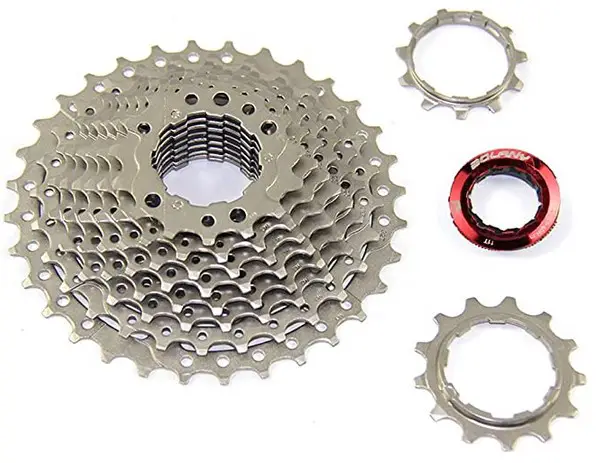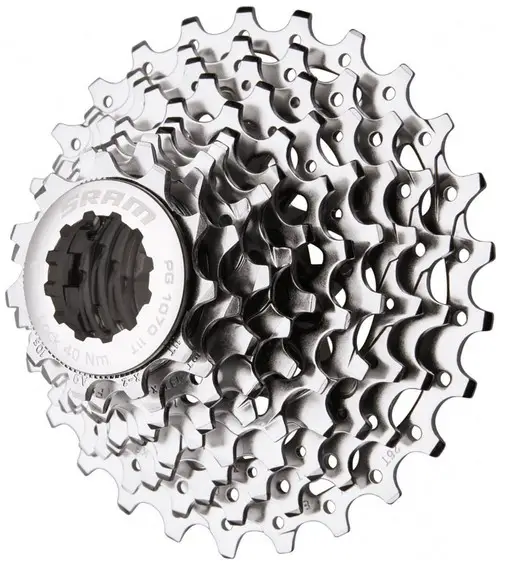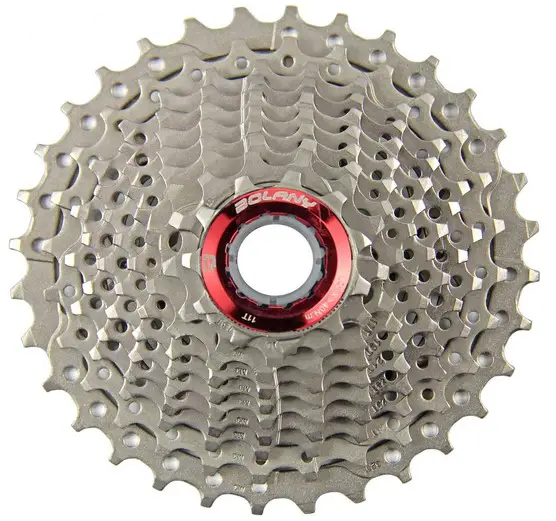Choosing the right cassette for your bike can be a difficult task. So, are you wondering whether you can put any cassette on your bike?
You can put a Shimano or SRAM cassette in both your mountain bike and road bike as their sprockets have similar spacings. However, Campagnolo road cassettes only work with Campagnolo drivetrains. Most cassette hubs fit in Shimano cassette cogs. SRAM cassettes and most Miche, IRD, and SunRace share sprocket spacings.
Its also worth noting that some SRAM 10-speed cassettes never fit aluminum-body Dura-Ace hubs. That’s why you need to check the specifications and the sizes to ensure you make the right decision.

So, What Exactly Is a Bike Cassette?
It’s a cluster of gears with metal projections called sprockets, attached to the hub and held together with a lockring.
Below we expound on bike cassettes.
Can I Put Any Cassette On My Bike? Choosing The Right Bike Cassette!
Bike cassettes come in different specifications. Besides, they feature varying numbers of teeth in each sprocket.
You’ll find common cassettes with 8,9,10,11,12 sprockets. In such a case, you make a decision according to the number of gears you prefer.
For instance, a 9-sprocket cassette with 3-chainrings upfront offers a 27 gears option (39). In addition, a 10-speed cassette and 2 front chainrings deliver a 20 gears drivetrain (210).
So, what factors should you consider when choosing a bike cassette?
1. Your Riding Terrain
The biggest determinant for your bike cassette is the type of terrain you’ll be riding on. Usually, a hilly terrain requires a large cog of 25 and above.
This increases cog spacings making it easy to ride on hilly terrain.
On the other hand, for flat terrain cycling, an 11-23t is your ideal cassette. This facilitates fast pedaling as it gives optimum cadence (number of revolutions per pedal).
2. Your Muscle Strength
Another factor influencing the type of cassette you choose is the fitness level. A smaller range cassette, (11-21) or 11-23, is suitable for strong riders.
On the flip side, weaker riders or newbies are good with 12-27 or 11-28 wider range cassettes.
3. Your Crankset
Bike riders should never underestimate the power of the crankset when choosing a bike cassette.
For a double standard 53/39 crankset, a 12-27t cassette would be ideal. For a more compact crankset 50/34, it’s good to buy an 11-23 cassette.
Types Of Bike Cassettes
Bike cassettes come in different specifications and sizes. Generally, there are mountain bike cassettes and road bike cassettes.
Top manufacturers for these cassettes include Shimano and SRAM. Fortunately, you can swap their respective cassettes during replacement.
This is because both manufacturers have cassettes with similar spacings between the sprockets.

Below find a detailed explanation of the mountain bike and road cassettes.
1. Mountain Bike Cassettes
Mountain bikes work best with wide-range cassettes, thanks to their higher cog count. This means that there are higher ratios close to each other on the smaller cogs.
The bigger the difference between the digits (11-34t), the wider the gear range. As a result, it’s possible to ride your mountain bike on hilly terrain.
Mountain bike cassettes come with 11-32t, 11-34t, 11-36t. In addition, they offer 9, 10, 11, 12 sprockets. For instance, size 10 cassettes have 10 sprockets plus 2 chainrings.
It’s also worth noting that cassettes are categorized in speeds. Thus, typical cassettes of 11-speed equal 11 sprockets plus the teeth.
They are then grouped according to sizes of 11-40T. The first number is the smallest sprocket (highest gear for fast pedaling at speed).
On the flip, the second number is the largest sprocket (lowest gear for climbing mountains).
The variety of gears give the best of worlds to mountain climbing riders. Wider gear spacings between each sprocket also offer an optimum hill climbing experience.
The majority of MTB cassettes use 9-10-11-12 speed cassettes. However, you have to spend extra bucks for expensive models like the 7-speed.
If not, you can go for a usual MTB cassette of size 11-34t. Shop for a mountain bike cassette here. (link to Amazon)
2. Road Bike Cassettes
Road cassettes come with 8,9,10,11 sprockets and a narrower gear range for efficient shifts. As such, they boost cadence (number of revolutions per minute).
However, most road bike cassettes have 12t-sprocket for the highest gear and 25-34 teeth sprocket as the lowest gear. A standard road cassette is usually a 12-25t road sprocket.
Nevertheless, the 12-32t cassette is aimed at beginners, sporty riders, or riders on hilly terrains. Whichever rider you are, shop for your ideal road bike cassette here. (link to Amazon)
Is It Possible To Interchange Bike Cassettes?
You might wonder if you can interchange your bike cassettes. Keep in mind that you can’t swap the cassette sizes.
A 10-speed cassette is replaced with a 10-speed cassette. However, it’s possible to interchange them if you replace the whole drivetrain.
It’s important to replace your MTB cassette when it is worn out. Also, you can upgrade to a lighter one. In this scenario, you’ll have to spend more on such a high-end cassette.
Bike Cassettes Replacement
You need to replace your bike cassette often, especially when it fails at its work. A worn-out cassette has a slipping chain or rough shifts.
It may also produce unusual sounds or contain fewer teeth on the largest sprocket of your mountain bike.
In such cases, you should replace the cassette with one with a similar number of sprockets. Typically, an 8-speed cassette cannot replace a 9-speed cassette as the additional gears need a chain with a different width.
It also needs a new shifter, different chainrings, and a new front derailleur.
So, check if the rear derailleur is compatible with your new sprocket as larger sprockets need long-cage models, of up to 36 gears. On the other hand, a shorter cage fits in higher gears of up to 28 teeth.

When To Replace A Bike Cassette
When you’ve covered 1,000 miles with your bike, check its cassette’s condition. The cassette and chainrings wear out fast, so replacing your chain every 2,000 miles keeps your bike at optimal performance.
Your terrain and –mountain vs. road- determine the level of tear. If teeth of the frequently used cogs look more worn out than those of the less-used cogs, consider a replacement for your cassette.
You can either replace individual parts of the cog, or the entire system, which is the best option.
How Much Does It Cost To Replace A Bike Cassette?
Budget-friendly cassettes cost $20-$30 to replace, but a good Shimano or SRAM cassette would cost you $50-$150 to replace. You can also go for top-class versions worth up to $300-$500.
If you don’t do a DIY cassette replacement, you have to factor in the labor cost of $20 to get the job done.
It’s mandatory to replace your chain alongside your cassette. So, get ready to spend an average of $15-$30 as the chain cost.
How To Replace Bike Cassette
You need special tools to replace your bike cassette. They are a new cassette, lockring tool, cassette plier or chain whip tool, adjustable wrench, and bike grease.
Follow these steps;
- Take the rear wheel out before the removal of the quick-release skewer.
- Insert the cassette pliers on the chain whip tool on a single end of your cogs
- Put the lockring tool on the remaining end
- In this step, you can use the adjustable wrench if the lockring doesn’t have a handle
- Remove the old cassette with the chain whip tool while moving the lockring tool anticlockwise. This unlocks the lockring.
- Later, remove the old cassette.
- Take the new bike cassette and insert the spacers and cogs to fit in the splines
- Put in place the lockring, and then screw it with a lockring tool
- Grease the system to avoid threading
- Put back the quick-release skewer before reattaching the rear wheel.
Bike Cassette Maintenance
Frequently clean your bike cassette thoroughly several times per year. Exercise maximum care when cleaning the hub and make sure no solvent comes into contact with it to prevent dissolving the grease in the bearings.
Replace your chain when replacing the cassette as the latter wears out faster than the former. Always ensure that the chain and the cassette sync with each other. A 10-speed cassette goes with a 10-speed chain.
If your chain stays in poor condition, your cassette teeth wear out fast. Bike riders on the beach where sand gets in the drivetrain or in wet areas where the chain rust should replace the chain regularly.
Final Thoughts (Can I Put Any Cassette On My Bike?)
Bike cassettes are an essential part of your bike and come in different sizes and specifications. Mountain bike cassettes differ from road bike cassettes in terms of the number of teeth found on the sprockets.
Ensure that you keep the bike cassette in good condition and replace it after reaching its mileage. As a rule of thumb, replace your bike cassette alongside your bike chain for efficient cycling.
Also Read:
